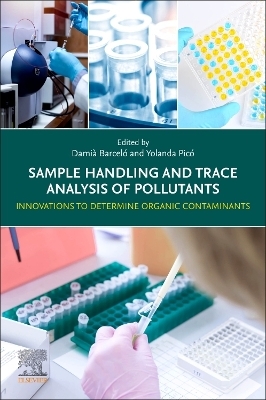
Sample Handling and Trace Analysis of Pollutants
Elsevier Science Publishing Co Inc (Verlag)
978-0-323-85601-0 (ISBN)
This book is an excellent resource for postgraduate students, environmental chemists and analytical chemists, as well as those working in environmental laboratories, laboratories of official environmental controls, universities and the private sector.
Prof. dr. Barcelo Damia, Director of the Catalan Institute for Water Research (ICRA) and Professor at the Institute of Environmental Assessment and Water Research (IDAEA), Barcelona, Spain. His expertise is in water quality assessment and management, fate, risk and removal of emerging contaminants in wastewater treatment plants and analysis, fate and risk of emerging contaminants and nanomaterials in the aquatic environment. He published over 900 papers, 200 book chapters and has h index 91. He was a coordinator of several national and EU projects and at the moment he coordinates two EU projects: GLOBAQUA , on multiple stressors in the aquatic environment and SEA-on-a-CHIP, on the development of sensor technolgies for emerging contamaints in marine aquaculture. He is CoEditor in Chief of the journal Science of Total Environment and the book series Comprehensive Analytical Chemistry, both form Elsevier Yolanda Pico was born in Valencia, Spain, in 1964. She received her Ph.D. in Pharmacy in 1992, after which she was a post-doctoral fellow at the Vrije Universiteit of Amsterdam (The Netherlands) (1992/1993) and at the “La Sapienza University (Rome, Italy) (1996); Assistant Professor of Nutrition and Bromatology at the University of Valencia (1993-1998). Since 1998 she is full Professor of Nutrition and Food Science at the Department of Preventive Medicine and Public Health, Food Science, Toxicology and Legal Medicine of the University of Valencia and the Head of the research group in Food and Environmental Safety (SAMA-UV). Her research interests include identification of unknown compounds by liquid chromatography-mass spectrometry, microextraction separations and environmental and food safety, development of new analytical methods to determine contaminants in food and the environment and the application of methodologies to the risk assessment of different hazard within both field. She is the author of nearly 240 peer-reviewed papers 180 scientific papers in journals of SCI, 30 book chapters and editor of 3 books on Food and Environmental Safety and Applications of liquid chromatography-mass spectrometry. She has a hirsh index of 47 has been a member of various international scientific committees of renowned institutions. Other relevant activities include the following: Member of the Scientific Panel of Plant Protection Products and their Residues (PPR Panel) of the European Food Safety Authority (EFSA) (2009-2012) and partner of projects related with food, water and soil quality at the different national and international levels. She has been supervising 9 Ph.D. theses on food analysis (1992-2014). Her main focusses are: risk assessment of the exposure to pesticide residues, veterinary and human medicines, illicit drugs, perfluorinated compounds, and other emerging compounds including toxic-analytical aspects, of bioavailability and bioaccesibility, synergisms, toxicity evaluation and detoxification.
Section 1. Field Sampling Techniques, Sample Preparation and Extraction
1. Analytical methods for determining organic compounds in air
2. Passive samplers for the analysis of organic compounds in water samples
3. Extraction of organic contaminants from grab and composite water samples
4. Separation, clean-up and recoveries of trace organic contaminants from soils and sediment
5. Separation, clean-up and recoveries of trace organic pollutants from biota
6. Handling of food samples
Section 2. Trace analysis of organic pollutants
7. Gas chromatography-mass spectrometry
8. Liquid chromatography-mass spectrometry
9. Suspected and non-target high resolution mass spectrometry
10. Imaging techniques. The increasing role of imaging mass spectrometry
11. Immunoassays of organic contaminants
12. Fundamentals and applications of biosensors for environmental analysis
13. The role of nanomaterials and nanoparticles as analytical tools
14. Smartphone as a Portable Detector, Analytical Device, or Instrument Interface
Section 3. Quality Assurance, Reference Materials, Chemometrics and Data Dissemination
15. Certified reference materials for the quality control of measurements in environmental monitoring
16. Standard reference materials for the determination of trace organic constituents in environmental samples
17. Guidelines to establish the quality assurance. Analytical parameters, Inter-laboratory studies
18. Data dissemination and repositories
19. Interpretation of environmental data using chemometrics
20. Determination of the uptake and accumulation of emerging contaminants in soil and plant treated with wastewater
21. Endocrine disrupting compounds
22. Current issues on micro- and nanoplastics
23. Determination of nanomaterials in the environment
24. Detection of antibiotic resistance genes (ARG) in water and sludges
25. Identification of metabolites and/or degradation products of environmental contaminants
26. The anthropic fingerprinting in wastewater: Wastewater based-epidemiology
| Erscheinungsdatum | 14.12.2024 |
|---|---|
| Sprache | englisch |
| Maße | 152 x 229 mm |
| Themenwelt | Naturwissenschaften ► Biologie ► Ökologie / Naturschutz |
| Naturwissenschaften ► Chemie ► Analytische Chemie | |
| ISBN-10 | 0-323-85601-2 / 0323856012 |
| ISBN-13 | 978-0-323-85601-0 / 9780323856010 |
| Zustand | Neuware |
| Informationen gemäß Produktsicherheitsverordnung (GPSR) | |
| Haben Sie eine Frage zum Produkt? |
aus dem Bereich


